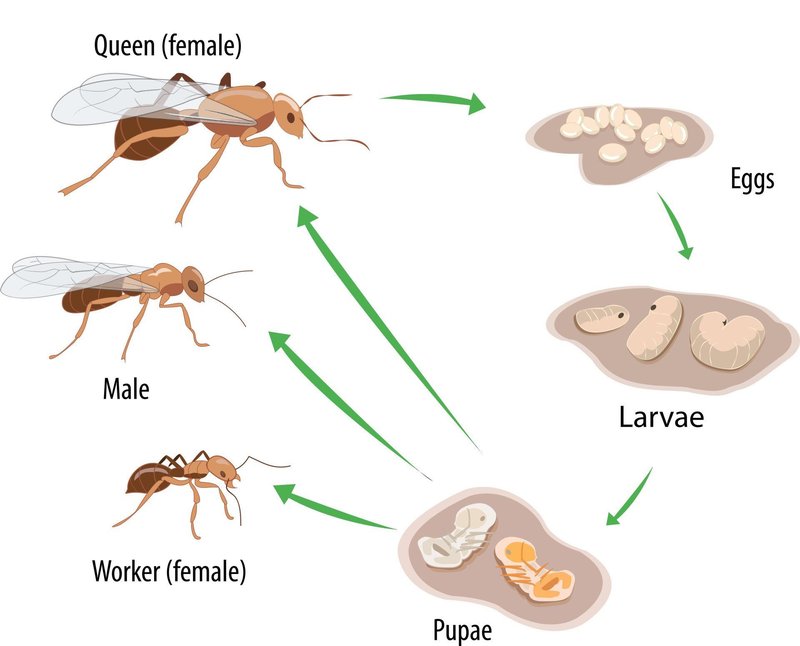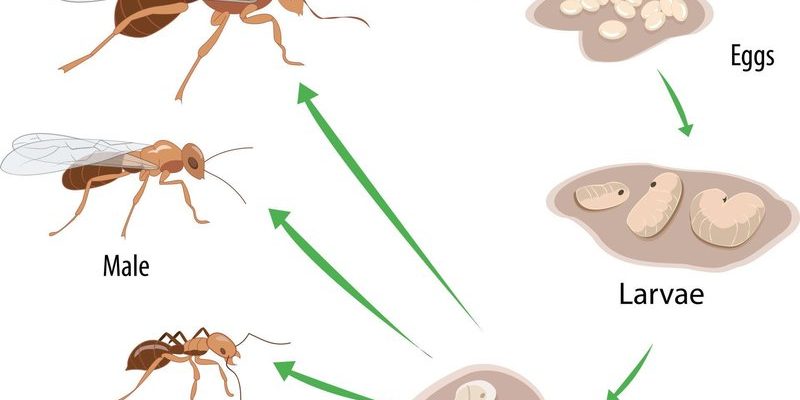
Ants are social insects that live in complex communities, which is pretty impressive when you think about it! Their lifecycle is divided into four main stages—egg, larva, pupa, and adult. Each stage is crucial for the development of the ant and contributes to the colony’s overall health and efficiency. Let’s dive into this journey and explore what happens at each stage.
1. The Egg Stage
The lifecycle of an ant begins with the egg stage. Ant eggs are tiny, often resembling little grains of rice, and they vary in color depending on the species. When a queen ant mates, she stores sperm and can lay fertilized eggs, which will become female workers or future queens, and unfertilized eggs that develop into males.
Eggs are usually laid in a safe, moist environment in the nest, where they’re protected by worker ants. These workers keep the eggs warm and clean, kind of like a parent keeping a baby safe. If you observe closely, you might see the queen diligently laying hundreds or even thousands of eggs at one time!
2. The Larva Stage
Once the eggs hatch, they turn into larvae. This stage is all about growth. Larvae are creamy white and have no legs, which might make them look a little like worms. At this point, they’re completely helpless and rely on worker ants for everything.
Here’s where things get interesting. The worker ants feed the larvae a diet of protein-rich food, which can include insects, nectar, and even pieces of fungus. The larvae eat and grow, shedding their skin multiple times as they outgrow it, just like how kids have to get new shoes every year. Generally, this stage lasts a few weeks, depending on the ant species and environmental conditions.
3. The Pupa Stage
After the larval stage, ants enter the pupa stage, which is somewhat similar to a caterpillar forming a chrysalis. The pupae are not in a cocoon like butterflies, but they do become immobile and undergo a remarkable transformation.
During this time, the pupae are often placed in specific areas of the nest, where they can maintain the right temperature and humidity. It’s a delicate balancing act. Depending on the species and temperature, this stage can last from a few days to several weeks. Inside their protective casing, the larvae are developing into adult ants, with all their features starting to form. It’s an intricate metamorphosis that deserves a round of applause!
4. The Adult Stage
Finally, the moment arrives when the pupae emerge as adult ants. They’re often soft and pale at first and will darken as they mature. Adult ants have specific roles based on their type—workers, soldiers, or reproducing queens. Each role is vital to the success of the colony!
Workers handle foraging, caring for the queen’s eggs, and maintaining the nest. Soldiers protect the colony from threats. Queens are responsible for reproduction. It’s a well-organized system that ensures survival and efficiency. As the adults get to work, they’ll also continue to care for new eggs and larvae, keeping the cycle going strong.
5. The Importance of the Ant Lifecycle
Understanding the lifecycle of an ant isn’t just about appreciating these remarkable creatures; it also highlights their ecological importance. Ants contribute to soil aeration, seed dispersal, and even pest control.
By breaking down decaying organic matter, they help recycle nutrients back into the earth, promoting healthier plant growth. So, every time you see an ant, remember the tremendous journey it has taken from a tiny egg to a bustling adult with a job!
6. The Lifespan of Ants
You might be curious about how long this lifecycle lasts. The lifespan of ants varies by species and role. Worker ants typically live for a few months to a couple of years, while queens can live for over a decade! Isn’t that wild? The queen’s longevity allows her to lay thousands of eggs throughout her life, ensuring the colony’s growth.
7. The Role of Environment
Ants are highly adaptable and can thrive in many environments, from rainforests to deserts. The conditions where they develop—temperature, humidity, and food availability—are crucial to their lifecycle. For instance, warmer conditions can speed up development, while cooler ones can slow it down.
If you’re thinking about observing ants in action, consider setting up an ant farm to get up close and personal with their lifecycle. It can be a fun and educational experience!
8. Conclusion
The lifecycle of an ant, from egg to adult, is a captivating process that showcases nature’s ingenuity. Each stage plays a vital role in the survival of the species and contributes to the ecosystem. By uncovering the journey of these tiny insects, you gain a better understanding of their world and the important roles they play in our environment.
So, next time you see an ant scurrying by, take a moment to appreciate the incredible journey it has taken. It’s not just a pest—it’s a wonder of nature, filled with challenges and accomplishments that deserve our respect!

